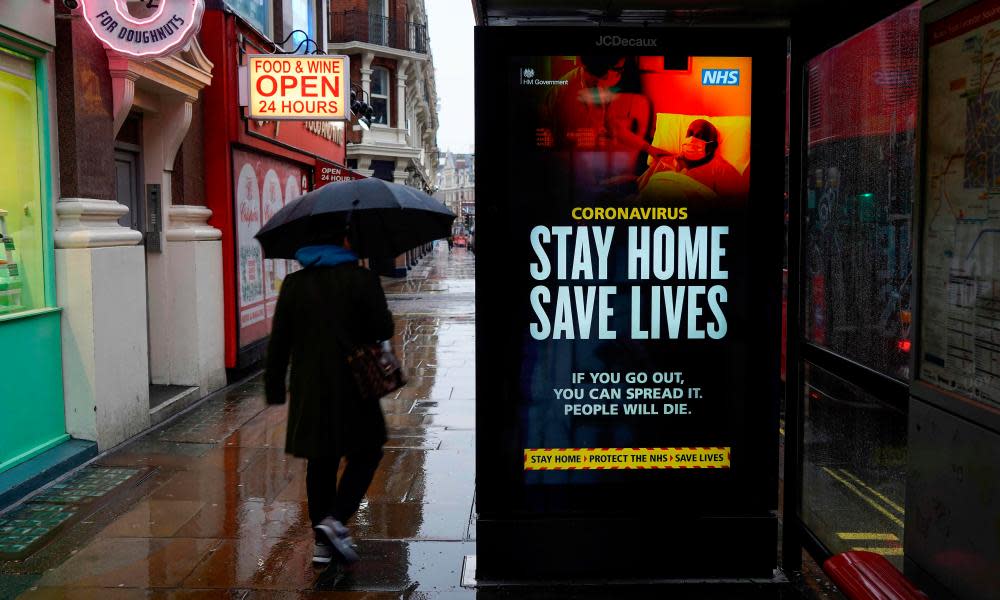Covid infection numbers levelling off in parts of England

The number of people testing positive for coronavirus has begun to level off in some parts of England, but restrictions must remain in place, experts have said.
There are now more Covid patients in hospital in the UK, and more on mechanical ventilation, than in the first wave of the pandemic. However, new data suggests the tide may be beginning to turn.
The latest R number for the UK is 1.2 to 1.3, and 1.1 to 1.3 in England, with the number of new infections in the UK growing by between 2% and 5% every day, according to the government’s Scientific Advisory Group for Emergencies (Sage). The week before the R value for the UK was 1.0 to 1.4. R indicates the average number of people to whom an infected person passes the virus.
While overall the figure suggests the outbreak is continuing to grow, there are regional differences, with London, the south-east and the east of England showing signs that infections could be levelling off or even, potentially, falling.
In the capital, the R number is between 0.9 and 1.2, with the number of new infections somewhere between shrinking by 2% and growing by 3% a day. But experts warn the figures do not reflect the present moment in time.
default
“These estimates represent the transmission of Covid-19 over the past few weeks due to the time delay between someone being infected, having symptoms, and needing healthcare,” the team behind the government’s R number data said.
The Sage estimate is based on R values calculated from a number of teams, including the MRC biostatistics unit at Cambridge University whose own analysis is more upbeat – potentially because their number is calculated from different types of data to some other groups, including from mobility trends.
According to the Cambridge team, the number of infections in England overall is declining. Infections are still on the rise in the south-west and the north-east but appear to have plateaued in the east Midlands and West Midlands, and are falling in regions including London and the south-east, with the R number for London estimated to be about 0.6.
The Cambridge team say the trends are likely to reflect a drop in the spread of the virus following the introduction of tier 4 restrictions, school holidays and reduced movement over the festive period, but the impact of the national lockdown has yet to become apparent.
Despite the positive signs, they say measures to reduce the spread of the disease will be needed for some time. “The prevalence of infection remains high and the demand on healthcare services is currently extreme, so continued restrictions are needed to lower these levels and to maintain control over transmission,” they say.
According to government figures, the number of people testing positive for coronavirus in the UK (by date reported) reached a high of 68,053 on 8 January and fell to 48,682 on Thursday, jumping again to 55,761 on Friday.
Prof Karl Friston of University College London, who is a member of the Independent Sage group of experts – a separate body to the government advisory group – said it appeared new cases had reached their peak for the nation as a whole.
“It is difficult to directly interpret the reported cases because fluctuations in reported cases depend upon the number of virus tests conducted – and self-selection sampling bias. However, when you model the underlying incidence and prevalence, then it looks as if new cases have now peaked,” he said.
“This is further confirmed by a number of other metrics that look as if they are peaking,” he added, referring to data from sources such as the Covid symptom study, led by King’s College London, which suggests the R number across the UK is 0.9, with cases slowly beginning to fall in England and Wales. Friston said modelling of real-time parameters also suggested the R number was now below 1.
But Dr Michael Tildesley, of the University of Warwick, who is part of the SPI-M modelling group that feeds into Sage, said more time was needed before it became clear how case numbers were changing.
“There are early signals in the south-east and London that spread may be slowing but there is still a lot of uncertainty around this,” he said.
Dr Kit Yates, a co-director of the Centre for Mathematical Biology at the University of Bath and a member of Independent Sage, agreed. “I think we probably need to wait a couple more days to see whether we expect a plateau or a fall [in national rates] as the impact of schools going back and people going back to work [is seen],” he said.
Prof Steven Riley of Imperial College London, who is also part of SPI-M, said it was important to see how quickly cases fell. “In order to take pressure off the NHS, we need to get to low prevalence in the community as quickly as possible. A slow decline is going to lead to very high levels of Covid patients in hospitals for a prolonged period,” he said.

 Yahoo Movies
Yahoo Movies 
